What can we do right now that has a high chance of saving money, improving cash and/or retaining customers?
~DEFEND
What changes do we need to make now [to products/services/content calendars/offers/ad copy/ad creative/messaging/campaigns etc] so our marketing efforts are relevant to the current climate and our brand is positioned correctly, both now and in the coming months?
~ADAPT
What can we do now and next to drive growth and competitive advantage over the next 6 months?
~GROW
In the unprecedented situation affecting the world, most businesses are facing some kind of disruption, some much more than others.
Depending on how your business has been affected will depend on the options available to you and how best to approach and navigate the next few months. This is also a time when real change is going to occur and new cards are dealt.
Some competitors will shrink and some will grow. If you’ve successfully addressed any ‘holes in the ship’ then the focus should probably shift back to sales and marketing to help you further improve your position.
We put together the Defend, Adapt, Grow (DAG) approach to help suitable businesses save money and retain customers, grow and engage their audience and ultimately lay the foundation for growth and competitive advantage, whether now or in the next 6-12 months.
Companies that struggled post-recession had often “switched to survival mode, making deep cuts and reacting [too] defensively.” That “survival mode” meant “that they later must spend far more than they saved in order to recover from their prolonged absence from the media landscape.” “If your first reaction is to cut all costs, all people, all marketing,” cautions Tim Stewart, “you have fewer tools available for your remaining choices.”
Source
The 4 Categories Of Businesses & Suitability Of Defend, Adapt, Grow
At the time of this writing, there seems to be four main categories of business emerging:
1. Unable to trade
This could be due to government closures or restrictions, your customers or clients being unable to transact, supply chain issues or a number of other reasons. If you’re unable to trade and revenue has pretty much ceased, then of course Defend, Adapt, Grow or any digital marketing strategy is probably not available or unlikely to be helpful.
2. Hibernators
Your business might still be trading, but with a focus on survival, ‘battening down the hatches’ to ride things out. Either budget simply isn’t available for adaptive marketing, it’s not suitable right now, or for whatever reason, the decision has been made to pause all activity. You’ll likely be watching events unfold, making the best decisions you can with the resources you have, until you reach the point where things start to turn around for the better.
When things do start to turn around, you’ll be behind, trying to recover lost time, progress and revenue. The faster you can hit the ground running when you reach this period, the better and faster you might recover and gain a competitive advantage in the new market.
Now might be the time for information gathering and increasing your knowledge. Combine this with your existing experience to inform strategic planning. Working to get ‘all your ducks in a row’ during this hibernation period, could give you the best chance of a speedy recovery post pandemic.
3. Survivors
You’ve experienced some level of negative impact to your revenue and/or profit, which could range from mild to significant. The key difference here is that, although the size of your target market may have reduced, or their mindset changed in relation to purchases, a lot of your clients or customers are still in-market. You still have reasonable demand for your products and services, whether legacy products and services or new offerings as a result of a pivot, and you’re still generating a level of profit.
You need to Defend and Adapt your marketing strategy so your message is relevant to the current climate and you reach the right people with the right message at the right time. Your main priority might be to maintain and recover in the short term, with a view to growth in the medium to longer term.
You might still have experienced a negative impact though, which may have resulted in you reviewing your expenses. Marketing budgets might be restricted and re-allocated as there needs to be a much greater focus on ROI during the recovery phase.
4. Boomers (as in business is booming, not the generation!)
Your business is booming or at least continuing to grow at a reasonable rate, as the current situation has caused a surge in demand for your products and services. You are probably either way too busy to do anything with marketing and simply trying to catch up with demand, or you want to make the most of the opportunity and look to scale your marketing activity. The goal likely being to accelerate your business over the next few months, while helping as many people as possible by serving their needs through your valuable offering.
You probably still need to adapt though. Marketing messaging pre-pandemic, will probably feel irrelevant at best and miss the mark in connecting with your audience. At worst it could now appear cold, insensitive or even offensive, negatively affecting your business and causing lasting brand damage.
To add some context to this, here’s an infographic from Stackline that shows the top 100 fastest growing and declining categories in eCommerce:

The Defend, Adapt, Grow Framework
Think of a recession as a sharp curve on an auto racetrack—the best place to pass competitors, but requiring more skill than straightaways. The best drivers apply the brakes just ahead of the curve (they take out excess costs – DEFEND), turn hard toward the apex of the curve (ADAPT), and accelerate hard out of the curve (spend and hire before markets have rebounded – GROW).
Source
The Defend, Adapt, Grow approach discussed in this article is aimed at helping ‘Survivors’ and ‘Boomers’ adapt and improve their digital marketing strategy to survive and thrive throughout the coming months.
It’s designed as a path towards recovering and/or adapting from a digital marketing perspective, so you can return to, or maximise a growth trajectory. It’s not a business strategy model. It’s a way to get marketing right in the short, medium and long term view by taking action now.
Note: Some businesses will need to Defend & Adapt so they can Grow, while others need only Adapt.
IMPORTANT: This is NOT about profiteering from a crisis. We do not condone playing on people’s current fear in order to sell products and services. This is about adapting your marketing so that it’s relevant and empathetic to people in the current climate and communicated in the right tone.
Defend
Objective: What can we do right now that has a high chance of saving money, improving cash and/or retaining customers?
Most businesses have experienced some degree of loss and unless you’re in the ‘Boomer’ category, chances are this applies to you.
Budgets need to work harder, so review your marketing strategy with a renewed focus on ROI.
But before we get into tactics and changes, Defend starts with qualitative research and understanding your audience and how things have changed for them.
The best thing to do is speak with your existing customers or clients and ask them.
Hearing it directly from them by having a conversation with them, should provide you with insights you can use to inform your Defend activity (and later Adapt and Grow). Taking the time to speak to your customers and ask them how they are doing will also improve your relationship with them.
Show you care now and be flexible to their needs and you could create a very loyal customer and a strong advocate for your brand.
I heard a good quote recently in relation to this: “When you feel helpless, become helpful. It will change your state.”
Here’s a few questions to keep in mind that you might want to try and obtain the answer to during your conversation with your customers:
- What was a day in the audience’s life like before this? What about now?
- What do they believe about the situation?
- What is currently happening in their world?
- What are their priorities?
- What are their challenges?
- What are their main concerns today that relate to your solutions?
- Has their buying cycle length changed?
- What are they now defining as great value?
- What are they defining as too costly?
- How have their desires changed?
You should also carry out quantitative research and analyse your data. Some trends you might uncover are:
- Changes in search volume
- Likely lower volume for bottom of funnel ‘in-market’ keywords unless you’re in a Boomer category, but likely higher volume for informational search
- Increased social media use and reach
- With a much higher percentage of people at home 24/7, social media use is higher across all major platforms – Facebook, Instagram, YouTube, LinkedIn etc
- Changes to click through rates
- Likely higher (depending on the link or ad copy) as people seem to be in an information gathering mindset
- Changes in conversion rates
- Likely lower unless in a boomer category
- Changes in buyer behaviour
- People may still have the need for your products and services, but are being more conservative with their money. You might see longer sales cycles, lower order value, lower conversion rates, shorter subscriptions etc
- Changes in CPC or CPM
- Likely lower due to less competition and/or higher CTR, increased audience size and higher engagement
- Changes in outbound email open rates
- Likely lower and you need to stand out as there are probably more people going after the same prospects
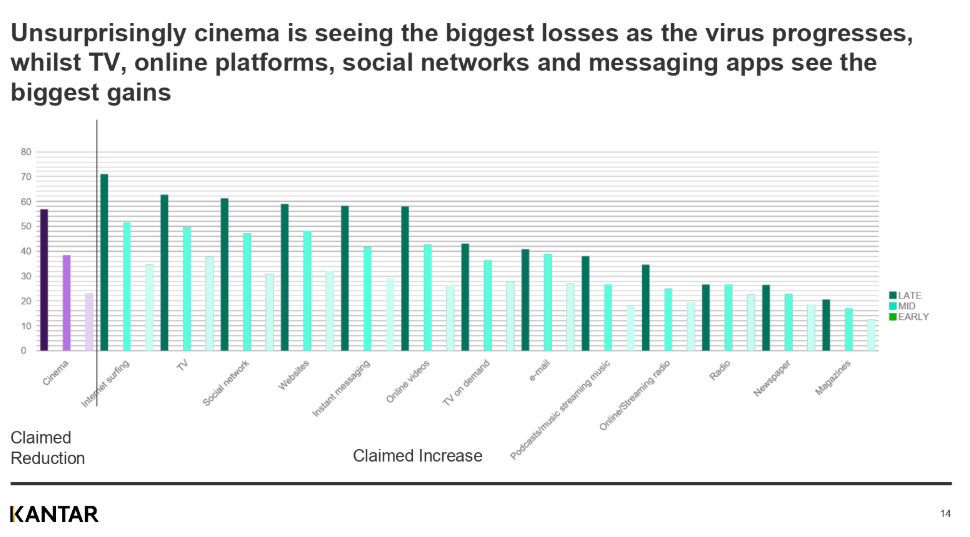
So the Defend stage looks at what we can be doing now to immediately start saving money, improving cash and retaining customers.
Here’s a list of ideas you might want to use in the Defend phase to help stimulate your ideas.
The tactics listed below are things we’ve either personally seen/experienced or things we’ve heard from trusted sources:
- Go through all of your copywriting and all of your ads. Make sure everything is relevant, tactful and in the right tone and context.
- Go through all your automations and email flows. Make sure everything is relevant, tactful and in the right tone and context.
- Cashflow is king right now and many can take a hit on profit in exchange for revenue. So it might be worth revisiting your offers:
- Subscription products: Offer a couple free months or temporary discounted subscription.
- Retaining the subscription payment is the most important thing. If they cancel, you might lose them forever and you definitely lose all the revenue. If they continue with a subscription, even at a reduced rate, you retain the customer (who will likely scale back up to a full subscription at a later stage) and a portion of the revenue
- Roll out new downmarket or salvage offers
- If you discount your existing core offers, there is a risk of cheapening them, negatively affecting your brand in the mid to longer term.
- “Why couldn’t you sell it to me at this price before?”
- “Why can’t I remain at a lower price?”
- An alternative might be to look at new, cheaper offers that people can’t compare to your existing ones.
- If you discount your existing core offers, there is a risk of cheapening them, negatively affecting your brand in the mid to longer term.
- Subscription products: Offer a couple free months or temporary discounted subscription.
- Focus on becoming ruthlessly efficient with your marketing budget
- Revisit your current/lifetime customer value because it’s probably different now (lower) to what it was. Is it 20% lower? 30%?
- Here’s a formula that might help:
- Three quick metrics to start:
- What is a customer worth to us on their first purchase, on average? (Immediate Customer Value)
- What is a customer worth to us over their lifetime, on average? (Customer Lifetime Value)
- What is our required Customer Payback Period (CPP)? If we spend a dollar acquiring a new customer today, how long are we willing to wait for that dollar to come back?
- A customer has a value on day 1, day 30, day 60, day 90, and day 365.
- If you need to make a profit on day 1, you must set your CPA below the value of the first customer transaction.
- If you are able to wait 30 days, you can set your CPA much higher. As can a marketer who is able to wait 90 days, and so on.
- Remember to use both initial customer value and lifetime value in your decision making.
- All else being equal, a higher CPA enables more channel options, faster customer acquisition and more total revenue, if the business can tolerate the payback period.
- Three quick metrics to start:
- Here’s a formula that might help:
- Once this is done, revisit your marketing and media strategy based on the revised numbers for acceptable CPA, ROAS etc.
- Review your marketing mix and look for channels or areas that generate low customer acquisition cost. When planning budget allocation, focus your efforts here as the priority and optimise for this. In addition to keeping costs low to acquire customers, the customers that you do acquire now, might increase in value at a later stage
- Note: with some channels CPC/CPM might be lower at present which might contribute to a customer acquisition cost that meets your revised targets
- Look 6-12 weeks in the past when analysing your data and reviewing where to shave budget. This timeline ensures you have data before things drastically changed. This will give you an indication of areas that will start working well again when we come out of this period. If you have the runway, you want to be present and hit the ground running on the upswing
- When reducing spend, use the scalpel not the axe!
- Revisit your current/lifetime customer value because it’s probably different now (lower) to what it was. Is it 20% lower? 30%?
- If lead numbers go down, look at which personas are converting and consider increasing volume if possible.
- Ensuring the right mix of paid (channels that drive) and organic (channels that build) activity
- For example: You might have experienced a drop in performance from organic, but this is likely due to lower impressions/demand. You don’t want to lose traffic and search visibility by pausing SEO. It could be much harder to recover from this if competitors gain search share and the performance of the channel will remain low once demand returns if you lose your organic presence. The ROI is potentially high from organic so defend what you have worked hard to build, maintain the revenue currently generated and reap the reward of higher ROI when demand returns.
Adapt
Objective: What changes do we need to make now [to products / services / content calendars / offers / ad copy / ad creative / messaging / campaigns etc] so our marketing efforts are relevant to the current climate and our brand is positioned correctly, both now and in the coming months?
You have to act like business is open and create more structure and discipline but your routines need to adapt and evolve.
The current struggle could be the thing that propels you to success if you use this time to your advantage. Use the fire behind you to force you to make changes, test, innovate and adapt at a far, far faster rate than you would in normal circumstances.
Speed beats perfection right now and if you take this approach, you could make significant gains in your business over the coming months.
—
You have to acknowledge the situation and adapt. Period.
Even if you’re one of the few businesses that hasn’t experienced much change in relation to products, services and operations, you still need to adapt your marketing communications.
The daily life of your audience has been turned upside down. Their mindset and behaviour is very different now to what it was earlier in the year, and the conversations they are having and the topics they are talking about are also different.
If you don’t adapt your communications, you will stand out as being tone deaf, irrelevant, cold, insensitive or even offensive. Read the room and be the one who helps with your marketing.
Marketing Communications:
As a brand, you need to acknowledge the reality and join the conversations your target market are already having
“The world advertising typically reflects back to us—beautiful people in close contact, high-fives, face-touching, and generally having good times in public—is a life that feels far, far away right now. Even if most of the time that ad image was fake or at best highly idealized (has anyone ever had that much fun at an Applebee’s?), the world being sold at least seemed in the broad realm of possible. Now what? You’re gonna run an ad with the employee at the curbside takeout window looking like Dustin Hoffman in Outbreak, handing the to-go order to a driver with their mouth covered by a bandanna and wearing nitrile gloves and a cut-up trash bag around their body? Then she takes it home to her friends with everyone sitting in their isolated rooms enjoying their meals over Zoom? Nah. That’s a wee bit dark.“
—
This is the best and most simply stated way of adapting your marketing messaging I’ve seen:
“Tell people why what you are telling them matters now, in this new context we are in”
~Peep Laja
- For some brands, the first adaptive messaging (which may have to be adapted several times as things change), might have to be letting your audience know they can still buy your products and services and if there is any change to the process or availability. This includes overcoming any potential objections; safety concerns likely a predominant issue for many.
- Example: Uber Eats leaving the takeaway and departing vs greeting you
- Make sure the tone and context of your communications appreciates the situation we are in and speaks to the audience with this in mind.
- Your offers or angles need to be relevant to your brand and your audience’s life but don’t appear like you’re trying to profit from a crisis.
- Example:
- COVID-19 Sale! <<< NO! This communicates that you are running an offer just because we’re affected by COVID-19. It looks desperate and has no relevance to your brand, products and services.
- Healthy At Home Sale << Yes! Relevant, speaking to the audience in the context of their daily life, offer in line with their current needs etc
- Example:
- Your offers or angles need to be relevant to your brand and your audience’s life but don’t appear like you’re trying to profit from a crisis.
- Everyone is sick of generic ‘uncertain times’ messaging.
- Be relevant but don’t beat the drum of generic messaging.
- Tell people why what you are telling them matters now, rather than generic ‘uncertain times’.
- The general underlying tone of messaging is around “We’re all in this together”
- Adjust value proposition messaging to be more focused on saving costs vs making money. Several tests claim they are currently seeing higher responses from this, but run your own test to find out if it’s applicable to your audience
- Do something to help (and tell your audience about it… without coming across as humble bragging)
- This could be aligning your brand with a relevant cause such as donating money/proceeds to equipment for the healthcare industry
- People are paying attention to things now but not everyone wants every single story, all day every day, to be about the virus.
- People are looking for rest-bite and escapism from it all, so it’s OK right now to talk about subjects not related to the virus and not related to your products and services.
- We need to be empathetic and very helpful in our communications to connect with where their mindset is now and talk about things that are useful and appealing to them.
- Aim to educate, entertain and impact (make them feel something). If your post isn’t an offer and doesn’t do at least one of those 3 things, it might not be worth posting.
- Showing you’re human and being empathetic now and helping your audience to escape could be a huge value add, meaning you increase your following and build engagement, like and trust. People that will still be with you when we emerge from the crisis
- Here’s how people’s sharing and topic interests have changed according to Kantar:
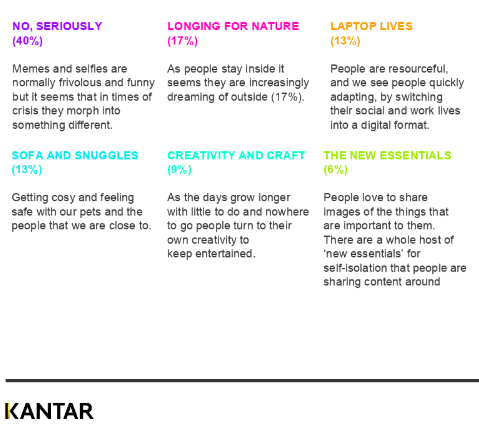
- People are feeling down right now and craving happiness.
- So sell happiness and use stories to connect your products and services to happiness.
- You’ll see leading brands do this all the time, not just now but in general. For example brands like CocaCola and McDonalds managed to [very] successfully connect happiness to their product.
- Sell the end result of how happy they will be when they get your product or service… but in the right context of their current daily life.
- Perfect example of Jack Daniels connecting their product to happiness and bringing people together right now:
- The best thing brands can do right now is “do good or make people feel good.” ~Henk Campher of Hootsuite
- Be optimistic and give your audience hope and your audience and influence will grow
- You need to truly believe everything will be OK (because this situation is temporary and will end at some point).
- Continually showing up with relevant marketing communications also helps to create a feeling of ‘normal’. Normal signifies hope and that things are OK or will be again soon. Your audience needs this right now.
- People are watching and the most confident and certain person tends to influence the less confident and certain person.
- Sales and marketing is a transfer of confidence and certainty, so if you aren’t confident, they won’t be either
Additional Resources and Examples:
- First brand Adapt responses to COVID-19
- Kantar COVID-19 Barometer Report Deck
- Examples of businesses adapting and responding
—
Example brands that are Adapting or running Adapted ads:
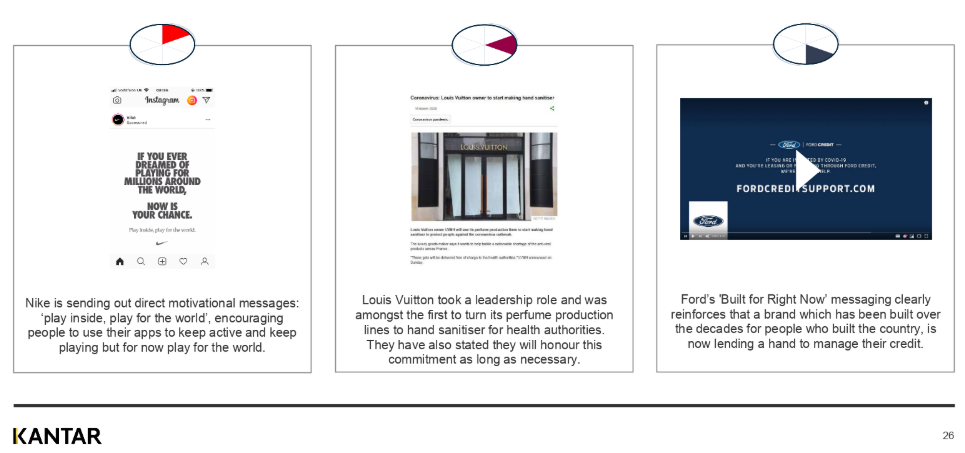
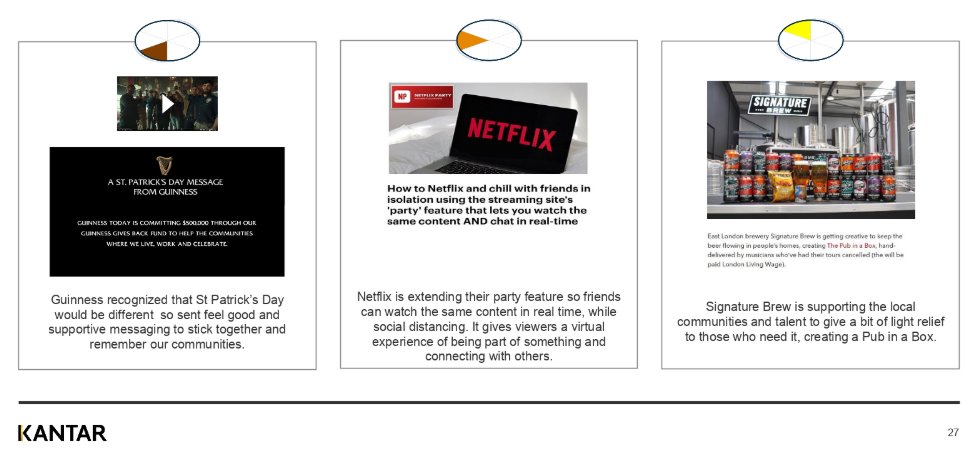
Soulara

Soulara adapting their ad copy to reflect the requirement for people to stay home, their fear of going to the supermarket and their desire to be healthy.
Celsius Coffee Co
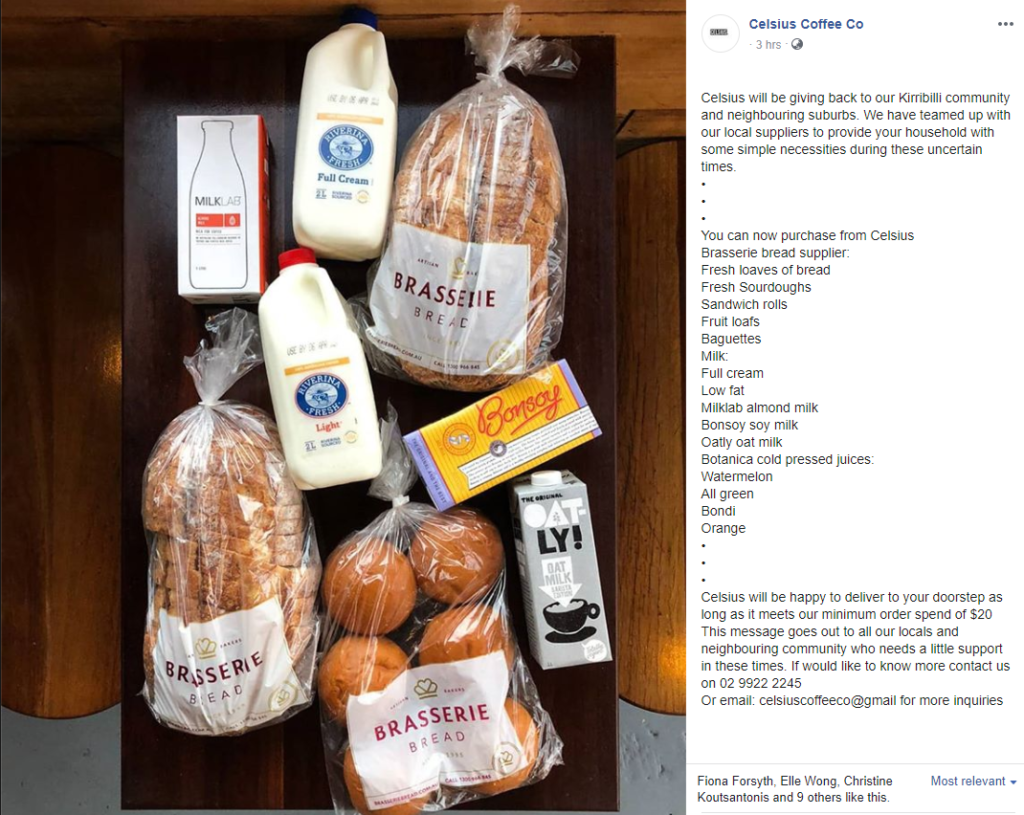
Celsius Coffee is delivering household necessities by partnering with their suppliers
Secretlab

Secretlab gaming chairs are running a ‘Stay at Home’ sale. It’s relevant because people game at home and they sell gaming chairs so the stay at home message links their brand and product to the audience’s lifestyle right now and the core message of stay home. Note, they are not running a ‘COVID-19 sale’ which would have no relevance and come across negatively.
Adapt Tactics
Adapting your marketing communications and getting this right is the most important thing you can do. If this misses the mark, then channels and tactics won’t matter.
But after having adapted your messaging strategy, here’s some tactical adaptations we’ve either seen or heard about from trusted sources.
- A focus on audience expansion rather than revenue
- If your target market has pulled back on purchasing your products and services and assuming you have enough runway and budget to Adapt and Grow, you might want to shift gears and instead of focusing on revenue, focus on growing your audience.
- People are in the information gathering mode. When uncertainty blends with a quieter period, this behaviour increases
- Think more ‘value first’ marketing. Provide value and be helpful, entertain, educate and impact (make them feel something): Discover -> Interest -> Opt In – so more content, social, lead magnets and less direct response offers (unless they are converting well of course)
- This might not be the best time to launch a new product for some brands, but it is a great time to build your subscriber list.
- Building an engaged subscriber list aid the success of future product launches (due to a larger audience)
- Redirecting budgets from offline and event marketing to digital, such as Facebook and LinkedIn Live events as well as content marketing and SEO.
- High-performing content published on your blog and social channels can be repackaged into virtual events.
- Reallocating media budgets to social advertising, influencer marketing and paid search but with an eye for return on ad spend
- Reallocating media budgets towards content
- This builds relationships and nurtures leads.
- This is playing the long game as you’ll be set to hit the ground running in the future when things turn around. There is a compound effect to content marketing and you can expect to see: increased traffic, improved relationships with prospects and customers (know, like and trust), increased search presence and SEO performance etc
- Remember, people are in the information gathering stage so the demand for high quality content that educates, entertains and/or impacts is at an all time high
- Reallocating budgets to improving conversion, user experience or data
- Improving the experience of landing pages
- New landing pages
- Revised copywriting
- Data and tracking audits
- Qualitative and quantitative research
- A/B testing programs
- Reallocating budgets from low performing response campaigns to brand campaigns
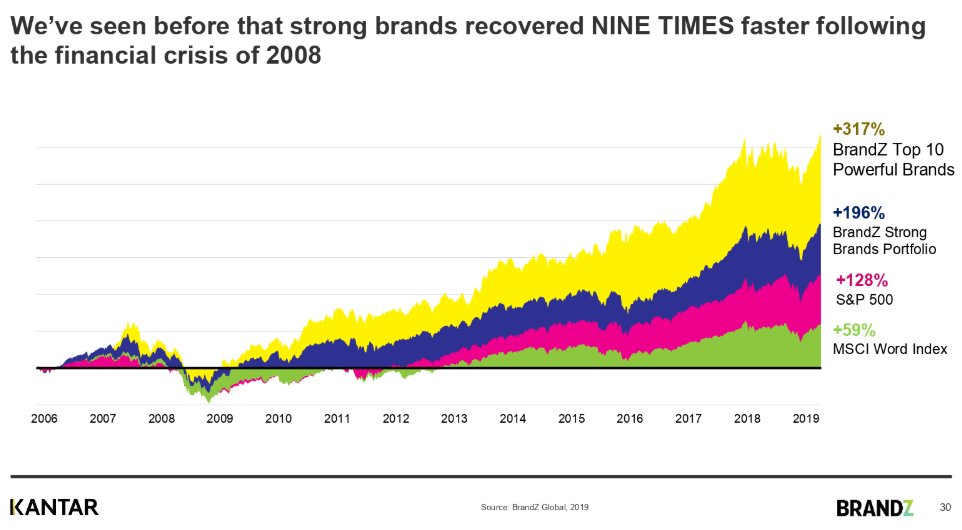
- When in doubt, build your email list
- If you’re struggling to identify what areas to focus on right now with your digital marketing, building your email subscriber list is always a good thing.
- This is a channel that you own and one that has the potential to perform well with high lifetime subscriber value, if not now then in the future
- The list also becomes a business and marketing asset and you can communicate with your audience for a very low cost anytime you like.
- Assuming you have an email list, double down on email marketing if appropriate.
- It’s low cost and effective when done right.
- If you’ve experienced a drop in revenue from other channels, giving email more focus could help to provide an increase in revenue but at the very least could strengthen your relationship with your existing subscribers and customers.
- Customer match targeting on channels like Google and Facebook allow you to to run targeted ads and offers to your subscribers across other platforms, again whether that’s appropriate to do now or in the future.
- Promoting carefully chosen products and services
- Essential and semi-essential products or products that make more sense right now are likely where demand is. Products that lend themselves to being at home or services that solve current and new problems people are facing will likely be welcomed by the market
- Ecommerce brands might want to run more discounts, mindful that many people have experienced a negative affect to their income or are generally more conservative at present
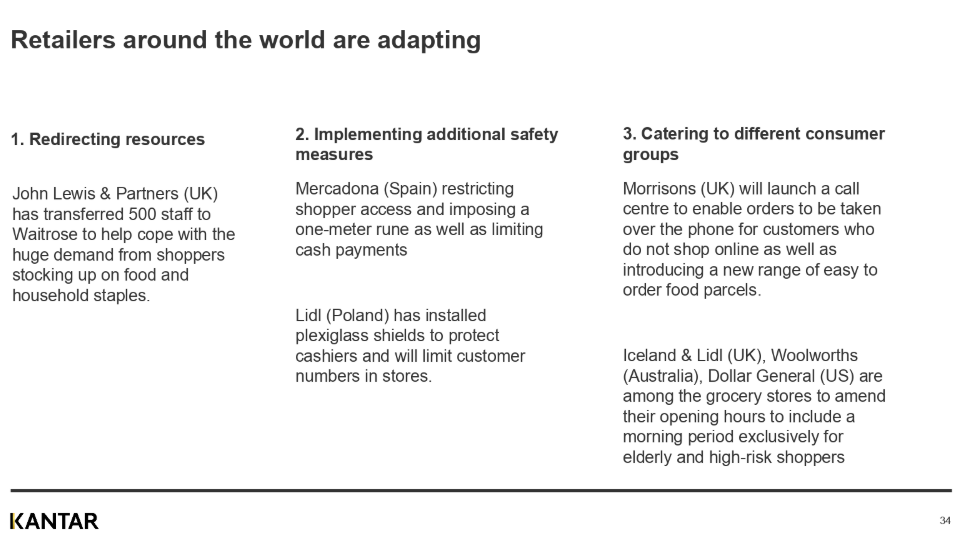
Grow
Objective: What can we do now and next to drive growth and competitive advantage over the next 6 months?
If your business is in the Boomer category and you’re experiencing a surge in demand (that you can fulfill), Grow will be about the now (of course with adapted marketing communications) and maximising this period, reaching the target audience effectively to let them know you can help them.
The Grow phase for Boomers will also be about gaining market share from competitors and planning ahead for the next 6-12 months. That planning may need to account for a reduction in demand as consumer mindset and behaviour changes post pandemic.
If you’re in the Survivor category, you’ll have successfully stabilised and adapted, or at least planned your Adapt marketing strategy based on the new normal and change of circumstances.
It’s time now to look further ahead at the next 6-12 months based on what you know.
Important: You need to consider how people’s behavior may change following the pandemic, both their buying behaviour, your inventory or services and your marketing communications.
Plan things in advance and fill the diary or activity schedule based on a predictive assumption of when things are back up and running. For Boomers this could also be a decline in demand depending on your industry sector.
Review your plan weekly and if things are taking longer to return to normality, push your pre-scheduled activity back. Likewise bring things forward if things start to turn around quicker.
The worst thing you can do is not pre-plan for this period or have an activity schedule to work to, because when things do return, you need to hit the ground running with a full schedule to make up for lost revenue (Survivors), be prepared to fulfill renewed and pent up demand (Survivors) or minimise any potential drop in demand (Boomers).
The worst thing would be to return with nothing scheduled and no plan meaning you are starting from scratch and either playing catch up or reactively winging it.
Things to consider when working on your Growth plan:
- What’s trending up that can be maximised?
- Products, services, channels, audience segments etc
- Which products and services are people still willing to pay market rate for?
- What segments are:
- Low volume, high ROI
- How can we get more of this segment?
- Increase marketing spend to reach more of this audience segment or promote more relevant offers, improve engagement through refined communications, test reaching this audience via other marketing channels
- How can we get more of this segment?
- High volume, low ROI
- What can we do to improve the ROI?
- Improve conversion rate, immediate customer value, 30 or 60 day customer value, reduce customer acquisition cost etc
- What can we do to improve the ROI?
- High volume, high ROI
- Maximise the channel and segment by prioritising budget here
- Low volume, high ROI
- With media consumption habits changing, what channels do we expect to be more or less popular over the next 6 months?
- Are there any new offers (or angles) we can create for new and existing customers?
- You will probably have been working to a marketing calendar pre-pandemic so revisit and rework this.
- Try to keep to your marketing calendar as best you can but obviously plan an Adapt version of the communications.
- Planning a Mother’s Day campaign? Great, still run with it but change the communications so it’s in the context of people’s lives at the time the campaign runs.
- Here’s a diagram from Harvard Business Review about the different types of audience segments during a recession or crisis, how they might respond and how you might be able to help them (offers):
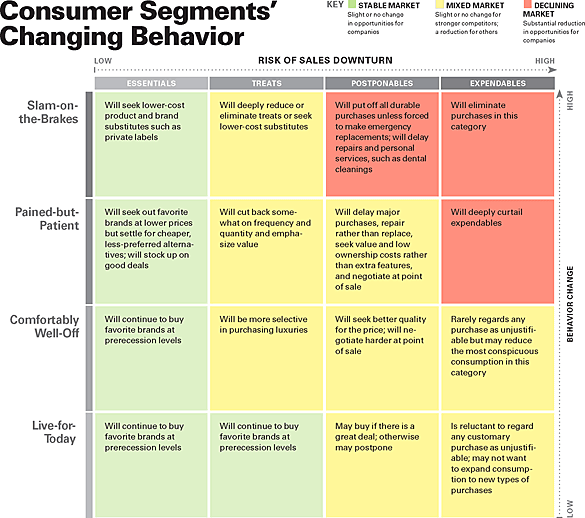
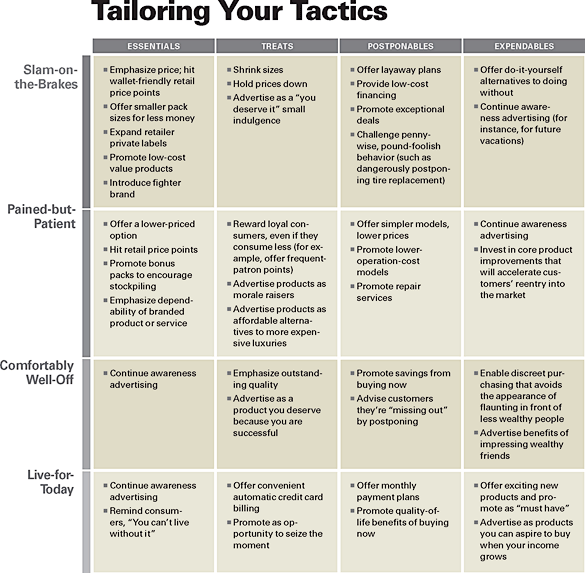
- If your business is booming or you have some runway with cash reserves, you might want to forward invest in hiring.
- Unfortunately there’s likely to be more talented people currently looking for a new opportunity so now might be a good time to secure top talent
- I’m NOT saying acquire top talent at a discount. Pay people what they’re worth or at the very least if they are out of work and you are a bit tight on cash, come to a mutual agreement to hire them but with a contracted salary review based on market rate at a future review
- Ramp up content and SEO (Builder channels – accumulates in contribution over time)
- You want to build up your assets now, that will work when we start to emerge so you hit the ground running when we do emerge
- Look at a conversion optimisation roadmap (Multiplier – raises the value and performance or digital marketing)
- You will likely have to test and learn much quicker due to the audience and market changes. Sometimes you might not have time to test at all and just move ahead with something based on heuristic analysis and whatever quantitative and qualitative data you have to hand. This might go somewhat against regular conversion optimisation, but being flexible and nimble now could generate growth
Remember, some of the biggest companies in the world started their business during personal or economic down cycles:
- Microsoft in ’75
- Apple in ’76
- Uber in ’09
- and more
This is the time to be resourceful, work to a flexible plan that accounts for the now and the next and regularly re-evaluate and adapt your plan as required.
The skills you are developing and building now around discipline and nimble adaptation, will stay with you and the business and support your growth not just now, but long term.
Greater discipline during boom times offered more flexibility during lean years. And getting it right during the lean years, Bain reports, has a massive impact on companies’ growth rate after things improve
Source
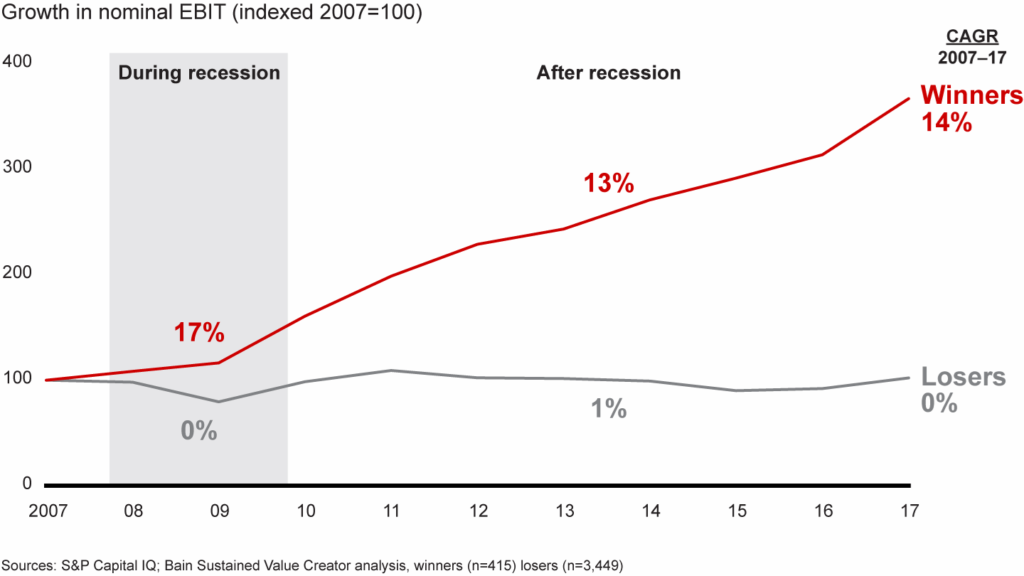
Wrapping Up
The Defend, Adapt, Grow framework is designed to help businesses improve their digital marketing strategy to survive and thrive throughout the coming months.
The key to making this a success, lies in getting the balance right between defence and offence. Saving money (Defend) and investing for the future (Grow). Also critical is how well and how quickly you can (Adapt) both immediately and on an ongoing basis.
Your customers and target market are where the important insights and data live. Stay close to your customers and speak to them regularly to keep your finger on the pulse of the market and use these insights, combined with quantitative data to inform and drive your Defend, Adapt & Grow digital marketing strategy.
Resources and Sources of Inspiration
- Marketing in Times of Uncertainty by Rand Fishkin
- This is an insightful post, especially for ecomm brands looking to expand their product line relevantly right now / pivot or new ecomm brands starting up
- Other good articles:
- https://www.forbes.com/sites/bernardmarr/2020/03/20/why-companies-turn-to-digital-marketing-to-survive-covid-19/#74e44522425c
- https://contently.com/2020/03/30/make-case-content-marketing-uncertain-times/
- https://searchengineland.com/reducing-digital-marketing-due-to-covid-19-read-this-first-331310/amp
- https://theclikk.com/advertising-spend-and-covid-19/
- https://www.fastcompany.com/90483063/were-all-in-this-together-why-brands-have-so-little-to-say-in-the-pandemic
- Website data and trends: https://www.similarweb.com/coronavirus
- 100s of meaningful COVID-related innovations, worldwide. Segmented by industry: https://www.covidinnovations.com/
- An article on growth and marketing in the middle of a crisis:
- Presentation decks:
- People we’ve drawn inspiration and advice from:
- Peep Laja and CXL
- Ryan Deiss and Digital Marketer
- Rand Fishkin & Moz
- Ed Mylett
- Andy Frisella
- Countless other authors of articles and blog posts, each other’s takeaways from webinars and videos and things we’ve all been reading, our own collective experience and more






